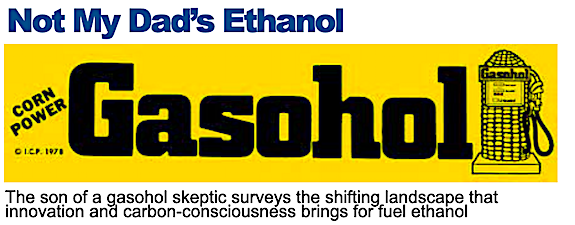Not My Dad’s Ethanol

By Jim Kendrick
Special to The Digest
As I attended the 39th annual International Fuel Ethanol Workshop & Expo in Omaha, Nebraska held June 12-14, memories of dinner table lessons received as the son of an Ag Economics professor come back to mind. I was taught to doubt ‘70s Gasohol, now known as E10. Although a home-grown fuel, “It’s not economically viable,” my father used to tell us. To my father, Gen zero ethanol’s most irksome aspects were that cost of its production was double that of petroleum but sold at a discount to gasoline, and the energy inputs to produce ethanol were greater than the energy in the finished product. Those economic injustices fomented his lobbying effort to stop US corn ethanol expansion. Today, carbon economics have taken center stage, energy security has come back full circle, and ethanol’s production also pencils out financially although price supports remain in place. This is not my father’s ethanol.
Other Nebraskans also developed a strong distaste for Gasohol. Ethanol’s solvent properties gave early adopters maintenance headaches. To this day in Nebraska, the ethanol hangover persists. Gas station retailers prominently display ‘Contains NO ethanol’ labels on non-E10 pumps. Although Nebraska is the second largest ethanol producing state, Chris Billey, Senior Vice President of Regulatory Affairs at Growth Energy said, “oddly enough Nebraska has one of the lowest effective blend rates in the country, it’s well below 10%.” The recent E15 law signed by Governor Pillen seeks to change that ranking and overcome Nebraskans’ aversion to ethanol use in vehicles.
Breaking through the 10% blend wall to higher percentages of ethanol in gasoline has long been sought by industry. Brian Jennings, CEO at American Coalition for Ethanol said, “I adore the E30 evangelists in our industry, but the truth is the way we’re going to get there is by taking the E15 step first.” Although for the second year we have seen nationwide waivers for summer E15 use, Geoff Cooper, President and CEO at Renewable Fuels Association (RFA) said, “We can’t rely on emergency E15 waivers every summer. That’s why we need Congress to pass legislation that removes this summertime barrier once and for all. RFA is looking for any and every opportunity to advance that legislation before year end. And get this, as a result of negotiations between RFA and the American Petroleum Institute, we even have the support of some of the big oil companies for this legislation.” Nationwide year round E15 use could increase ethanol blending by 5-7 billion gallons annually.
Cooper also introduced a prototype vehicle that reduces carbon emissions while giving consumers choice at an affordable price. Cooper said, “The right policies could drive creative solutions like RFA’s plug-in hybrid electric flex fuel vehicle (FFV). We think this is the first plug-in hybrid flex fuel vehicle in the world. Nobody has done this. A plug-in hybrid FFV combines the best of both worlds.” “With a full tank of E85 and a full charge of battery this vehicle can travel about 430 miles, which is pretty good for, what, an 11 gallon tank?” “It combines low-carbon liquid fuel combustion engines along with a small battery powered electric motor.”
Lifecycle analysis validates the carbon benefit when ethanol displaces petroleum for transportation. And let’s not forget what else ethanol displaces when blended with gasoline. One of ethanol’s least appreciated benefits is its octane number, replacing more harmful octane boosting additives, such as lead and MTBE. According to The US Department of Energy’s Alternative Fuels Data Center, more than 98% of US gasoline contains ethanol.
Ethanol has other uses beyond boosting octane and blending with gasoline. Michael AuBuchon, Managing Director of Fuel Strategy and Management at Southwest Airlines described investing in cellulosic ethanol company SAFFiRE. “It’s a big move on our part. It’s the only investment that Southwest has made in our history outside of an airline acquisition which should tell you the significance that we place in its success.”
AuBuchon continued, “We’re here because we are true believers that our future and our quest to be more sustainable as an airline is hugely dependent on the success of the ethanol industry more broadly. I will include in that what we’ll talk about today, SAFFiRE, but also, just to be clear, we are supporters of 1G ethanol to SAF as well.” “SAFFiRE does not seek to replace the first generation ethanol production. I want to be very clear about that, we seek to augment it via co-location with those sites and all the benefits that that affords.” “Part of the value proposition is definitely tied to the host ethanol plant.” “It’s going to be a very long runway, pun intended, to make this work, and Southwest is in it through our soon to be majority ownership in SAFFiRE to make that work.”
Southwest has chosen, but not yet announced, the location of the host ethanol plant for SAFFiRE’s pilot cellulosic ethanol operation.
Although the nascent cellulosic industry holds great promise for the future, look for more opportunities in Gen 1 ethanol and its co-products. From sustainable aviation fuel to renewable chemicals such as bio-ethlyene, and high protein distillers grains that can compete with soy based products and break corn out of what has been the low value ruminant-limited market, corn ethanol producers have a sustainable business future.
Category: Top Stories















